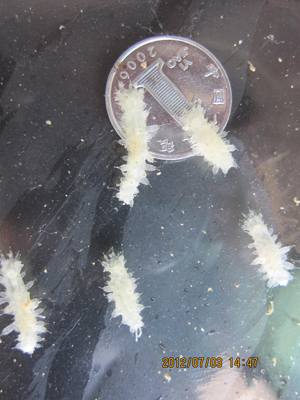
Parental individual of Bohadschia argus
863 Hi-Tech Research and Development Program of China, “artificial breeding technology of Bohadschia argus” which is undertaken by Associate professor Zhang Zhihuai of IOCAS, have made great progress. After more than three years of harvesting and culture, the researchers obtained 270kg parental individuals of B.argus Jaeger. Through continuous establishing and optimizing the conditions of feeding, ripening and reproduction, larvae and juveniles were finally successfully bred in 2012.

Juvenile Bohadschia argus
Presently, annual checking meeting of the project has been held in Lingao County, Hainan. The checking group was composed of experts from Hainan University and Hainan Fisheries Research Institute. The research group has bred more than thirty seven million B. argus larvae, and some of them have grown to the juvenile stage. Moreover, the experiment of seeding B.argus was performed in Wengtian sea field of Wenchang City, Hainan Province. The experts all agreed that Prof. Zhang’s group have achieved the goals of the year. Currently, the artificial breeding technology of B. argus was nearly mature, which will lay a ground for it to be a new high-value economic species for Guangdong and Haian province and also promote the development of the matchable mode of sowing it in tropical shallow seabed.

Experiment of seeding Apostichopus japonicus in tropical shallow bottom
At the same time, the work of Apostichopus japonicus introduction and domestication in Haian also made important progress. After four years of domestication, A. japonicus was able to feed at the sea water temperature of 27 ℃ and stably survive high water temperature of 31℃. On this basis, the research group successfully fulfilled artificial breeding of A. japonicus and began to perform the experiment of seeding A.japonicus in tropical shallow sea bottom of Haian.
Based on the above work, the research group will continue to optimize the large scale breeding, establish the tropical shallow seabed culture mode of, B. argus Jaeger and promote the industrialization of B. argus and A. japonicus in the South China Sea.
B. argus, the leopard sea cucumber, is a species of marine invertebrate belonging to Echinodermata, Holothuroidea, Aspidochirotid, Holothuriidae, Bohadschia Jaeger, 1833. It lives on coral reefs and exposed, sandy areas of the seabed at depths of between 10 feet (3.0 m) and 120 feet (37 m).Its geographic distribution is from the Seychelles Islands and Sri Lanka to the Ryukyu Islands, east to Tahiti, south to northern Australia, including south of Taiwan, Hainan Island and Hsisha Archipelago. In Singapore, Malaysia and the south of China it has traditionally been regarded as seafood treasures with high economic value, which can only be obtained by diving harvest. Before the project there has been no report on artificial breeding of B. argus.
|
|

Address: 7 Nanhai Road, Qingdao, Shandong 266071, China
Tel: 86-532-82898902 Fax: 86-532-82898612 E-mail: iocas@qdio.ac.cn


